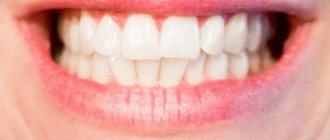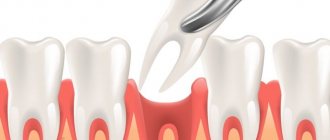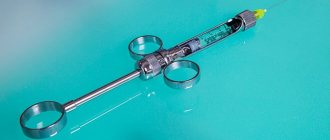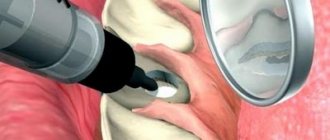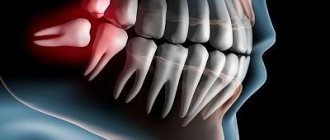From this article you will learn:
- tooth root removal – photos and videos,
- how long does it take for gums to heal?
- tooth extraction – price in Moscow (for 2022).
The article was written by a dental surgeon with more than 19 years of experience.
Tooth extraction is the most commonly performed surgical procedure in dentistry, which (in dental terms) involves extracting a tooth from the dental socket. In most cases, this is a fairly simple surgical operation, and difficulties arise mainly only when removing wisdom teeth - if they have massive curved roots, as well as with concomitant pathology of their eruption. Doctors who remove teeth are called “oral surgeons.”
It is also sometimes difficult to remove severely damaged teeth, which are difficult for the doctor to “grab” with special surgical instruments for tooth extraction - there are different types of forceps and elevators for this. It is also difficult to remove teeth whose root canals were treated using the resorcinol-formalin method (such teeth have a slightly pink color). This method makes teeth as fragile as glass, and therefore they begin to crumble under any mechanical impact from surgical instruments.
Removing a permanent tooth: photo
The main indications for tooth extraction are:
- difficulty erupting the eighth teeth,
- significant tooth mobility,
- the presence of a focus of inflammation at the apex of the root (in the absence of the possibility of high-quality filling of the root canal),
- complete destruction of the tooth crown, but only in those situations where the tooth root cannot be restored using a stump tab (on which an artificial crown is then fixed).
Important: very often, dental therapists send complex teeth for extraction that they don’t really want to bother with, but which could still be saved. For example, even with complete destruction of a tooth (if the preserved root is dense and not destroyed below the gum level), such teeth can be restored with a core inlay and an artificial crown. Patients should know that this option is much more reliable and better than subsequent restoration of the missing tooth with a bridge or dental implant.
How is tooth extraction performed?
Tooth extraction is usually performed under local anesthesia, but if you are intolerant to all known anesthetics or have high anxiety, you can perform tooth extraction under general anesthesia. The use of modern anesthetics with vasoconstrictors (for example, Ultracaine) guarantees a completely painless procedure, but provided that the patient does not abuse analgesics, alcohol or drugs.
In some cases, patients still complain of pain during the procedure, which most often occurs either with significant acute purulent inflammation or with the removal of lower molars (6-7-8 teeth). In both cases, the pain occurs more due to the fault of the doctor, because speaks of insufficient skills in administering conduction anesthesia. Let's give an example. In the upper jaw, the bone tissue is very porous, and therefore the injection of an anesthetic there is usually done into the gum - right in the projection of the tooth root. In dentistry, such anesthesia is called “infiltration”.
But when removing teeth on the lower jaw (primarily 6-7-8 molars), it makes no sense to inject an anesthetic near these teeth, because The bone in this area is very dense, and therefore the anesthetic simply will not penetrate to the roots of the tooth. To anesthetize large molars of the lower jaw, a more complex technique called “conduction anesthesia” is used. The injection is made in the area of the inner surface of the lower jaw branch, because It is in this place that the so-called inferior alveolar nerve passes, which provides pain sensitivity to the lower teeth on this side.
Infiltration and conduction anesthesia (video 1-2) –
The effect of infiltration anesthesia on the upper jaw occurs within a few minutes and lasts (depending on the type of local anesthetic) from 15 to 45 minutes. In this case, the onset of anesthesia is signaled to us by the appearance of numbness in the cheek or upper lip. The effect of conduction anesthesia on the lower jaw occurs within 5-10 minutes, but it can last up to several hours. In this case, the following symptoms tell us about the onset of anesthesia - there must be pronounced numbness in half of the lower lip, as well as the tip of the tongue.
Important: if the numbness of half the lip is weak or absent, it means the doctor missed and was unable to remove the anesthetic near the inferior alveolar nerve. And here you must either ask the doctor to repeat the anesthesia, or you will have to endure the pain. After numbness sets in, we proceed directly to tooth extraction, and depending on the complexity of the tooth, removal can be simple or complex. Because technically, these removal options are very different from each other - we will describe them separately from each other.
Types of tooth extraction
Tooth extraction is carried out using one of two methods, depending on the characteristics of the clinical case and the presence of complications. Before proceeding with tooth extraction, the doctor injects an anesthetic into the gum with an injection. Thanks to modern drugs, the procedure is painless for the patient.
Easy removal. The forceps are carefully and easily, but securely applied to the problem tooth. For the upper teeth, S-shaped ones are used, for the lower teeth, curved teeth are used. Using precise and gentle movements, the problematic tooth is loosened and then removed. The procedure does not require invasive effects on bone and soft tissues and takes about 15 minutes.
Difficult to remove. An incision is made in the soft tissue, then the surgeon peels off and removes the mucoperiosteal flap. If necessary, a small piece of bone is removed to facilitate access to the tooth root. Using special instruments, the root is divided into several parts, and then the problematic tooth is extracted piece by piece. Adjacent tissues are not injured during the operation. Typically a complex tooth extraction takes about 60 minutes.
Simple tooth extraction -
A simple tooth extraction means that it will last up to 5-10 minutes, and the doctor will not need to make an incision in the gum or drill out the bone tissue with a drill, or “pick” in the wound for a long time - looking for the broken off tip of the root.
The doctor simply removes the gum from the neck of the tooth with a stroker, applies forceps and swings the tooth. The maximum that is required after a simple removal is to put an anti-inflammatory medicine inside the hole, as well as apply 1-2 sutures (for example, to prevent bleeding). Simple tooth root removal: photo
How much does tooth extraction cost: a simple extraction costs in Moscow from 1,500 rubles, and in the regions it is usually cheaper (starting from 750 rubles). The cheapest way to remove a tooth is in a dental clinic at your place of residence - when using lidocaine, it is usually free, and they only offer to pay for imported anesthetic. The only exceptions are planned operations to remove, for example, impacted eighth teeth, which even in the clinic are performed only for a fee.
In video 3-4 below you can see how quickly teeth can actually be removed (even multi-rooted ones on the lower jaw). Without taking into account the wait for anesthesia, simple tooth extraction can take from 30 seconds to several minutes, and another couple of minutes may be needed to apply 1-2 sutures. The latter are sometimes worth applying during simple extraction, if there is a risk of bleeding or if a large multi-rooted tooth was removed. In the latter case, the wound is usually very large, and therefore there is a high risk of a clot falling out of the hole. Applying sutures allows you to tighten the edges of the gum above the socket of the extracted tooth, thereby reducing the size of the wound.
Simple removal of lower teeth (video 3-4) –
Important points that will allow you to avoid complications...
- What you need to tell your doctor - if you have allergies to medications, bronchial asthma, diabetes or problems with blood pressure - be sure to tell your doctor about it.
It is also important to warn about blood clotting disorders and the use of anticoagulants (including banal Aspirin, which thins the blood and promotes the development of bleeding and the formation of hematomas). It is very important for women to inform about the beginning of menstruation, because... these days, the number of platelets in a woman’s blood decreases by approximately 30-50%, and blood clotting depends on the number of platelets. If the doctor knows this, he will place a hemostatic sponge in the hole of the extracted tooth in advance or suture the wound (to prevent bleeding, which can happen at home or at night). - It is important to remove granulations from the socket - if a tooth is removed, at the apex of the root of which a cyst/granulation is diagnosed, then after extracting the root, it is necessary to inspect the socket and scrape out the cyst (if it did not come out along with the tooth).
If this is not done, then in 100% of cases inflammation of the socket will develop. Please note that the x-ray (Fig. 7) diagnoses a cyst. Because when the tooth was removed, the cyst did not come out along with the root of the tooth (Fig. 8), but remained in the wound - the doctor scraped it out with a curettage spoon (Fig. 9). This sequence of actions must also be followed when removing any decayed teeth in the absence of an x-ray. - After tooth extraction and granulation, if necessary, the hole is washed with an antiseptic solution, which is especially important when a tooth is removed against the background of purulent inflammation at the root apex. After this, a small amount of the antiseptic drug Alvogel is always placed in the socket, which reduces the risk of inflammation of the socket (there will be no need to remove it from the socket).
- Suturing – After a simple extraction, most dental surgeons rarely suture the wound.
Sutures allow you to bring together the edges of the mucous membrane above the hole, which is a good prevention of bleeding, as well as protecting the blood clot (which, as a result, cannot be accidentally rinsed out or damaged). At the same time, the risk of developing inflammation of the socket is reduced by 70-90%, and the pain syndrome after removal is also significantly reduced. I can advise everyone - even before removal, ask the surgeon to put 1-2 stitches on you. Even if you have to pay an extra 300-500 rubles for it. The main problems for patients usually begin precisely after tooth extraction, and sutures here will help prevent most possible complications (with which many then go to the doctor 3-5 times for repeat examinations). - What needs to be done after extraction - if the doctor does not forget, he will definitely tell you in more or less detail about how to care for the socket of the extracted tooth.
We have written detailed recommendations in these articles - → “Detailed recommendations for care”, → “Which analgesics are best to take.”
How to remove a tooth root (video 5) –
Removing the roots of a tooth, removing a broken tooth - in most cases, is easily carried out using elevators (with the help of which the tooth is dislocated from the socket), after which the root is simply removed from the socket with forceps. But inexperienced/indifferent doctors, when removing roots, try to apply forceps as deeply as possible, biting off a large amount of bone. The latter will then lead to the impossibility of installing an implant without bone grafting.
Removing a tooth root using an elevator (video 5):
How to remove a tooth with flux (video 6) –
If a tooth is removed due to gumboil (swelling of the gums, cheeks), then first the doctor will make a small incision of about 1.5 cm and release all the pus and wash the wound. Only after this will the causative tooth itself be removed and drainage inserted into the wound. The latter is necessary so that the edges of the incision do not stick together, and purulent discharge and ichor continue to come out of the wound and do not accumulate in the tissues.
Opening the gumboil before tooth extraction (video 6):
Stages of tooth extraction
Before extracting a tooth, the dentist examines the condition of the patient's oral cavity. An X-ray examination (panoramic or targeted X-ray) is performed, and if necessary, a computed tomography scan is performed. Diagnostic results help to identify the inflammatory process, the presence of cystic formations, the number of roots and the features of their location. After analyzing the data obtained, the doctor assesses the degree of complexity of the operation and announces the preliminary cost of removal. The procedure itself includes 3 stages.
- Anesthesia. The dentist performs antiseptic treatment of the oral cavity and anesthesia. Most often, local anesthesia (injection or non-injection) is used during surgery. Modern anesthetics are non-toxic and safe. They are administered with a carpule syringe with a very thin needle, which completely eliminates pain and discomfort.
- Extraction. The doctor begins to extract the tooth after the medicine has taken effect. First, the tooth is separated from the periodontal ligaments, carefully loosened and removed. A simple extraction, when the root is clearly visible, is carried out by the surgeon in a few minutes. Complex removal requires more time. If the roots are crooked and difficulties arise with their removal, the tooth is cut into fragments and removed in parts.
- Recovery. After the operation, slight swelling and pain may be observed. The doctor will tell you what needs to be done to ensure that the rehabilitation period passes without discomfort. Once the hole has completely healed, make an appointment and discuss tooth restoration options with your doctor. It is better to carry out implantation immediately before the bone tissue begins to atrophy.
How is complex tooth extraction performed?
There are situations where tooth extraction is almost guaranteed to be difficult. For example, multi-rooted teeth may have thin curved roots (Fig. 10), which prevent tooth extraction, and therefore one of the roots often breaks off. Or when it comes to removing the eighth teeth, which have a horizontal position or a strong tilt towards the 7th tooth.
It is also difficult to remove teeth whose root canals were treated with the resorcinol-formalin method, which at the same time gives the tooth tissue the fragility of glass and a characteristic pink coloration. There are completely “rotten” softened tooth roots, which are also difficult to remove (24stoma.ru).
As a rule, complex tooth extraction is carried out using a drill, which either saws out the bone tissue around the tooth, or the tooth is sawed into several parts, and parts of the tooth are removed separately. In the process of complex removal, an incision is also often required, and the hole is always sutured after removal. In terms of time, complex removal can take from 15 minutes to an hour (on average), which will depend, among other things, on the manual skills of the doctor.
Complex tooth extraction (video 7-8) –
In video 7 below, the doctor removes the root of a tooth and cuts out the bone tissue around the tooth with a drill (after removal, the hole is filled with bone material to prevent bone atrophy in order to subsequently install an implant without bone grafting). In the second video, the doctor saws the tooth crown into 2 parts with a drill in order to separately remove the roots and parts of the crowns.
It should also be noted that after simple tooth extraction, in about 3-5% of cases, inflammation of the socket develops (alveolitis), which requires treatment. But after a complex removal, the percentage of complications is much higher - from 25-30%. You can check how well the healing of the hole is progressing or whether there is inflammation in it by reading the article about the link below.
→ What does a tooth socket look like under normal conditions and with inflammation?
How is tooth extraction done?
Tooth extraction is often a simple but very delicate procedure. We know this very well - and we made sure that the tooth extraction was:
- painless. To do this, the patient is given an anesthetic, usually novocaine or lidocaine. This is the most unpleasant part of the tooth extraction process.
- fast. To do this, the doctor uses special instruments - surgical or classical, depending on the type of tooth extraction procedure. In the first case, the tooth is removed using a small incision in the gum or hiding the bone, in the second - by slightly loosening and quickly pulling out the tooth
- without unpleasant consequences. After the procedure, the doctor will tell you what is recommended to do for a quick healing process and what not to do to avoid problems.
This is all. In fact, tooth extraction is a simpler operation than it seems - and almost painless.
Tooth extraction in children occurs in almost the same way - only in a special office and by an experienced pediatric dentist. With the help of competent communication, the main cause of anxiety – fear – is neutralized, after which the tooth is removed as quickly as listed earlier.
But not only quick removal will guarantee the absence of unpleasant sensations and speedy healing. The main factor is proper oral care and small hygiene rules after tooth extraction. You can find out about them - the recommendations of the dentist and hygienist - below.
How to remove a tooth if implantation is planned -
If you are planning to install a dental implant in place of an extracted tooth, then under no circumstances should you first remove the tooth and then only go to an implantologist for a consultation - otherwise, along with the implant, you will then have to spend money on bone grafting. A tooth should only be removed by an implantologist, and this should be done as atraumatically as possible for the bone tissue, and bone material should be placed in the hole itself, covered with a membrane, and the hole should be sutured tightly.
And then after 3 months you will receive excellent bone for tooth implantation, and will not need bone grafting. In addition, there are models of implants that can be installed in the socket of an extracted tooth (immediately after its extraction) - this is the so-called immediate implantation technique. At the link below you can see the online implantation calculator we have developed. By selecting missing teeth and the implant option, you will immediately see the average cost of installing implants in your case.
→ ONLINE IMPLANTATION COST CALCULATOR »»»
Originally from the USSR™ – complex tooth extraction with a chisel!
A chisel is a tool from the times of the USSR, when there were no drills in surgical rooms for drilling bone tissue and sawing roots. The way teeth are removed with a chisel is more like a horror movie, when the doctor places the sharp end of the chisel on the bone tissue next to the tooth, while the nurse hits the chisel with a wooden hammer over and over again. Removing a tooth with a chisel is very traumatic for the bone tissue of the jaw and the temporomandibular joint, and often leads to complications.
Often the chisel slips off the bone and penetrates deeply into the soft tissues of the floor of the mouth; the chisel can also easily perforate the maxillary sinus of the upper jaw. Very often, the use of a chisel leads to injury to the mandibular nerve, which runs just under the tips of the roots of the lower teeth. Such an injury can lead to both the development of neuritis and prolonged pain, as well as prolonged numbness of part of the face. The use of a chisel is not permitted.
Tooth extraction: price in Moscow
How much does it cost to pull out a tooth? The price will primarily depend on the complexity of the removal. However, keep in mind that the cost of tooth extraction will also be affected by the price category of the clinic (where you go). In economy class clinics, the price can be 2-3 times lower compared to clinics of a higher price category. But if you want to have a tooth removed very inexpensively, the price will be lower in a paid department of a state dental clinic.
It is also worth remembering that if you have a medical insurance policy and a passport, then at your place of residence you can have your teeth removed for free (if we are talking about removing a decayed tooth or due to acute pain). But removal in the direction of an orthodontist or prosthetist in a paid department will be paid even in a public clinic, even if you have a policy. Prices below are for 2022.
How much does it cost to remove a tooth in an economy class clinic –
- Simple tooth extraction – 1,500 rubles. The price already includes anesthesia, but if you need to put a stitch, you will probably be charged another 300-500 rubles.
- Tooth extraction of medium complexity – 3000 rubles. This cost already includes anesthesia, stitches, and sometimes a re-examination.
- Complex tooth extraction – about 5,000 rubles. It is usually carried out by drilling out the bone and making an incision in the gum. This category also includes the removal of complex eighth teeth. The stated price includes anesthesia, stitches and, as a rule, repeated examinations.
How much does it cost to pull a tooth: price in clinics of medium and high price categories
- Simple removal – 3500 rub. This price already includes “all inclusive” (anesthesia, stitches, re-examination).
- Complex removal - from 7500 to 9500 rubles. those. with making an incision, sawing out the bone, and also includes the removal of complex eighth teeth. This price is also “all inclusive”.
Important: in most cases it is very difficult for the patient to predict the complexity of future removal. But there are guidelines. For example, all single-rooted teeth are usually removed very easily, even if it is necessary to remove a completely destroyed tooth. More often, removal is difficult when removing multi-rooted 6-7-8 upper and lower teeth.
Contraindications to tooth extraction –
All of the contraindications to tooth extraction listed below are not absolute. Those. removal for urgent reasons is possible even in these conditions, but only in a hospital setting and with immediate resuscitation support.
- hypertensive crisis,
- extrasystole, severe arrhythmia,
- hemophilia, leukemia, hemorrhagic diathesis,
- epilepsy, schizophrenia,
- condition after myocardial infarction, stroke.
Important: if you took anticoagulants (including Aspirin) during the week before the planned removal, it is advisable to postpone the removal for another 1 week. This is necessary to prevent the development of bleeding and hematoma formation.
Indications for tooth extraction
In dental practice, there are few cases when tooth extraction rather than treatment is recommended. These include:
- diseases and exacerbation of diseases of the teeth and gums - such as sinusitis of the maxillary sinuses, purulent periostitis
- cases when wisdom teeth interfere with normal life, eating - they scratch the inner surface of the cheeks or damage nearby teeth
- swelling and fracture of the jaw - in this situation, teeth located next to the treatment area are removed
- teeth due to which the entire dentition is deformed - this often occurs with malocclusion
- if the tooth cannot be replaced or restored
- cases when a tooth interferes with the installation of crowns or other types of prosthetics
That is, tooth extraction is recommended only in particularly difficult cases, when its presence can cause harm to health or other healthy teeth, interfere with treatment, or cause insufficient treatment of the disease.
It is also worth knowing that there are cases when tooth extraction is not recommended. These include tooth extraction during exacerbation of chronic heart and mental diseases, acute infectious diseases and pregnancy at certain stages. In this case, you will have to wait until the end of treatment or the time suitable for tooth extraction.
Is it possible for pregnant women to have teeth removed?
Tooth extraction during pregnancy is possible, but the decision about this should be made based on the duration of pregnancy and the severity of the inflammatory process, the presence of acute pain... During different periods of pregnancy, the strategy differs markedly -
- Tooth extraction during pregnancy in the 1st trimester is not recommended, but only emergency interventions can be performed when there is acute pain. You must understand that during this period there is a threat of spontaneous abortion, and therefore, if possible, removal should be delayed until a more favorable period. The most dangerous period of the 1st trimester lasts from the moment of fertilization until the end of the 8th week (then relatively safe).
- Is it possible for pregnant women to have their teeth pulled out in the 2nd trimester? The risk to the fetus during this period is significantly reduced. This is due to the fact that the formation of all organs and tissues in the fetus has already occurred. However, the toxic effects of anesthetics should be taken into account, and if possible, removal should still be postponed until the postpartum period.
- Tooth extraction during pregnancy in the 3rd trimester is possible, but preferably only in the first half of the third trimester to avoid premature birth. In the later stages, only emergency interventions should be performed.
Tooth extraction while breastfeeding has no restrictions. However, it is worth warning the dentist and asking them to use the least toxic anesthetics. Tooth extraction during menstruation is not recommended solely because of the unstable mental and emotional state of women during this period, but if there is pain, then you can safely go to the dentist. We hope that our article on the topic: Tooth extraction price, reviews – was useful to you!
Sources:
1. Higher prof. the author’s education in surgical dentistry, 2. Based on personal experience as a dental surgeon, 3. National Library of Medicine (USA), 4. “Outpatient surgical dentistry” (Bezrukov V.), 5. “Propaedeutics of surgical dentistry” (Soloviev M. .).
